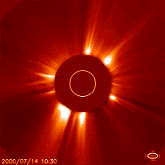Solar Spitwads
 Take a piece of paper. Make a little wad. If you're a kid, spit on it. Put it in a straw and blow hard. If your teacher sends you to the principal's office, here's your excuse: you were making a model of relativistic protons accelerated in the shock front of a solar coronal mass ejection (CME). It was done in the name of science. Really. Solar explosions and spitwads do have something in common. CMEs hurl subatomic particles across the solar system at nearly light speed. Those particles are guided, much like a spitwad in a straw, by the Sun's magnetic field.
Take a piece of paper. Make a little wad. If you're a kid, spit on it. Put it in a straw and blow hard. If your teacher sends you to the principal's office, here's your excuse: you were making a model of relativistic protons accelerated in the shock front of a solar coronal mass ejection (CME). It was done in the name of science. Really. Solar explosions and spitwads do have something in common. CMEs hurl subatomic particles across the solar system at nearly light speed. Those particles are guided, much like a spitwad in a straw, by the Sun's magnetic field.
The Sun is a star-sized magnet; its magnetic field permeates the solar system all the way from Mercury to Pluto and beyond. We don't feel it on Earth only because our planet's own magnetic field is locally stronger--but in interplanetary space, the Sun's magnetic field rules. Because the Sun rotates on its axis (once every 27 days), the Sun's magnetic field out among the planets has a spiral shape. Researchers call it 'the Parker spiral' after the physicist who first described it.
About the Author
NASA Marshall Space Flight Center
 The George C. Marshall Space Flight Center, located in Huntsville, Alabama, is the U.S. government's civilian rocketry and spacecraft propulsion research center. As the largest NASA center, MSFC's first mission was developing the Saturn launch vehicles for the Apollo program.
The George C. Marshall Space Flight Center, located in Huntsville, Alabama, is the U.S. government's civilian rocketry and spacecraft propulsion research center. As the largest NASA center, MSFC's first mission was developing the Saturn launch vehicles for the Apollo program.


